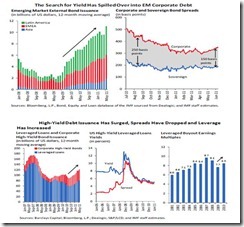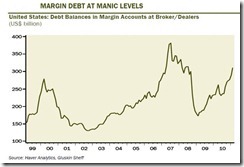Given the length of a project's life, a decline in the discount rate pumps up the present value of a capital project. An artificially low interest rate alters the evaluation of projects – with longer-term, more capital-intensive projects becoming more attractive relative to shorter-term, less capital-intensive ones. Steve H. Hanke, Boom and Busts
More Interventions Clouds Market Signals
Global equity markets continue to struggle.
This could part of the cyclical growth slowdown which has been deemed as a “growth scare”. This could also signify seasonal factors at work.
Chart above from chartoftheday[1]
This could also represent dour sentiment which has been looking for events to connect with (e.g. Greece Crisis). This may also account for the waning effects of global stimulus measures.
Aside from the forces above, from my contrarian perspective, these could be part of the grand scheme of central planners to generate conditions that would justify further interventions[2].
Interventions of various forms seem as becoming routinary.
For this week, renewed thrust to rig the commodity markets has been initiated by the banning of OTC trades[3] in US commodity markets as part of the latest Dodd-Frank Act targeted at hedge funds.
So the new rules could force some renewed liquidations or put some selling pressures on the commodity markets over the coming sessions.
In the meantime, commodity investors are likely to consider alternative avenues to go about trading the markets.
Considering the next wave of bailouts (China[4] and Greece[5]), there will likely be more direct interventions ahead
As Carmen M. Reinhart, Jacob F. Kirkegaard, and M. Belen Sbrancia writes[6],
Other approaches to creating or expanding demand for government debt may be more direct. For example, at the height of the financial crisis U.K. banks were required to hold a larger share of gilts in their portfolio. Greek, Irish, and Portuguese banks have already liquidated a substantial fraction of their foreign assets and used the proceeds to buy domestic public debt. Thus the process by which debts are being placed at below market interest rates in pension funds and other more captive domestic financial institutions is already under way in several European countries. Spain has recently reintroduced a de facto form of interest rate ceilings on bank deposits. Similar trends are developing in Eastern Europe.
Moreover, the use of capital controls by emerging markets hoping to control destabilizing inflows (hot money), potential overheating, rising inflationary pressures, and related competitiveness issues have found far greater acceptance in the international community than at any time since the breakdown of the Bretton Woods system. Indeed, many emerging markets have already begun to use such policies.
Therefore we should expect more volatility on either direction, as the distortions in the economic distribution of resources are amplified.
Selling Strains Vented on Equity and Currency Markets
Strains of the fumbling equity markets worldwide have also been evident among ASEAN bellwethers.
Chart from Bloomberg
As one would note, the price motion of ASEAN’s bellwethers appear to be highly correlated. This is with the exception of Malaysia’s KLCI (red line), which appears to have grabbed the leadership from Indonesia (orange) or Thailand (yellow). Apparently this shifting leadership dynamic signifies more evidence of the ongoing rotational process.
So far, the current failing seen in global markets hasn’t had a substantial adverse impact on the above bourses. Except for Malaysia which popped to the winning column, the former top gainers have currently posted minimal losses.
This dynamic has not been limited to equities.
Currencies of the above ASEAN economies have also tumbled against the US dollar. This downside pressure has also been seen in the currencies of most of the major Asian economies.
For the Peso, part of the current weakness has reportedly been from massive intervention by the local central bank or BSP to stem the Peso’s appreciation.
The Danske Research team writes[7],
BSP has intervened massively in the FX market to stem the appreciation of PHP. While capital controls have so far not been introduced, they remain a possibility
If these interventions are not mopped up, then this should boost liquidity into the system that should add to the inflationary pressures that would have the main point of entries on the asset markets.
Phisix: Market Internal Points to Consolidation and Not Reversal
This week’s losses have been reflected on the broader market.
All sectors were in the red, mostly led by the Financials and the Service sector.
Friday’s bizarre last minute selloff, which brought the Phisix to the negative zone after drifting the entire day on the positive (see below chart), was apparently led by the marked declines of Bank of the Philppine Islands (-4.34%), Banco De Oro (-5.73%) and Globe Telecoms (-4.2%).
Chart from technistock.net
Combined with earlier losses this week, a vital segment of the decline of the Phisix can be traced on the performances of these heavyweights, that is in addition to PLDT.
The massive selldown on the above issues last Friday appears to be locally driven. Only Globe Telecoms posted foreign selling.
Yet in spite of the selloffs, BPI and Globe Telecoms were not even on the top 10 most active list, where both ranked 16th and 21st respectively. Meanwhile, BDO had only php 44 million in value traded.
This implies of the panicked reaction of the seller whom I suspect could be the handywork of one entity who probably got spooked for whatever reason and dumped their holdings at the closing bell.
Foreign trade registered positive this week, which means that the recent declines have been locally driven.
And despite the second week of losses, market sentiment have not been bearish overall.
The above chart shows of the daily trades (bottom) and the Phisix (top; courtesy of stockcharts.com)
Ever since the Phisix breached 4,000 level, one would note of a spike in the daily number of trades which usually coincides with upticks in the Phisix.
In September 2010, when the Phisix soared from 3,600-4,400, the number of daily trades spiked to reach the 20,000 level.
Another attempt at a runup in late December also coincided with an upsurge in daily trades to a similar level. The ensuing correction in the Phisix which lasted from January to March of this year saw a decline of the number of issues traded.
But this remained elevated compared to the first semester of 2010, where the Phisix traded from 2,800 to 3,600 and where number of trades ranged from 5,000-10,000.
We seem to be seeing the same cycle playing out today.
The point is, the number of trades reflect on the market’s sentiment. People tend to trade more often during upside swings than during downturns.
The elevated and ascendant (red trend) sentiment indicator reveals that despite current corrections, the local market has, so far, has resisted bearish assaults on market psychology.
In short, these signfiy signs that the Phisix has merely been consolidating and not enduring from a major reversal.
I would further posit that should there be any major reversals, both the Phisix and the daily number of trades would breakdown from their current trends simultaneously.
I don’t see this happening soon. Definitely NOT when the local and foreign monetary policies remain accommodative. And definitely NOT when policy stimulus, the addiction to debasement of the currency, could get activated anytime soon.
IMF Acknowledges Impact of Low Interest Rates
As final thought on this abbreviated discussion on the equity markets.
I’d like to point out that the IMF has acknowledged that a low interest rate environment encourages speculation.
From the IMF[8] (bold emphasis mine)
Low interest rates in advanced economies are promoting pockets of re-leveraging by lowering the “all-in” cost of debt capital for corporate borrowers. This is encouraging investors to use financial leverage to generate sufficiently attractive returns on equity. Although credit spreads are still higher than before the crisis, ultra-low short-term interest rates mean that the cost of debt is now lower, both for floating-rate and fixed-rate debt. This lower cost of borrowing renders debt servicing ratios more favorable, even at higher debt loads, thereby enabling companies to operate with more financial leverage
Has the IMF finally seen the light which the Austrians have long been pounding? This premise of IMF essentially lends credence to or validates the Austrian Business Cycle Theory.
Further, the causal relationship between low interest and financial leverage only goes to prove that business cycles or boom bust cycles underpin most of the actions in the financial markets and likewise plays an important role in the developments of the real economy.
And these relationships have become increasingly evident in Emerging Markets bonds (corporate and sovereign) markets, as well as the US leverage loans and high yield bond markets.
And we can see that this dynamic has also been a factor in influencing the actions in the US stock markets (chart from David Rosenberg[9])
As I have long been saying, today’s markets have largely been a function of inflationism.
[1] Chartoftheday.com Dow Average Monthly Gain, June 3, 2011
[2] See Falling Markets, QE 3.0 and Propaganda, June 12, 2011
[3] See War on Gold and Commodities: Ban of OTC Trades and ‘Conflict Gold’, June 18, 2011
[4] See China Prepares For Massive Bailout!, June 1, 2011
[5] See Serial Bailouts For Greece (and for PIIGS), June 4, 2011
[6] Reinhart Carmen M. Kirkegaard Jacob F. and Sbrancia M. Belen Financial Repression Redux, IMF Finance and Development, June 2011
[7] Danske Bank Slowdown in global recovery takes toll on EM equities, Emerging Market Briefer June 15, 2011
[8] IMF.org Markets Pricing a Mid-Cycle Slowdown, Global Financial Stability Report Market Update, June 2011
[9] Rosenberg, David Breakfast with Dave, vccm.squarespace.com, April 11, 2011








No comments:
Post a Comment